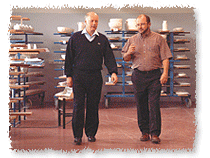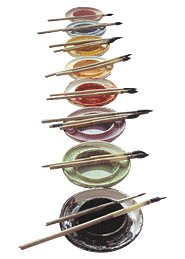
Pottery is the result of three elements: water, earth, and fire. A noble member of the ceramics family, pottery combines clay, originally present at the Toulven cove, on the banks of the Odet River which majestically passes through Quimper), the water of the river, and the fire which came from burning the wood which abounded in our fair Cornouaille.
The first known pieces date from the Gallo-Roman period. They were found in the Locmaria neighbourhood, along the Odet. The manufacture of ordinary items lasted until the 18th century, at which time arrived in Quimper Jean-Baptiste Bousquet, who was the source of the development of faïence in Quimper.
His son, Pierre Bousquet, set up shop as a master potter in 1708 and gave an important boost to the development of the artisan activity with the production of stoneware destined for daily use and for religious observances.
It was the son-in-law of Pierre Bousquet, Pierre Belleveaux, who in 1731 supplied the savoir-faire of the stencils, the colors and the glazes, as well as the invaluable “décor à la touche” (“the brush stroke”), a style at that period particular to Nevers pottery.
|
|
The Quimper painters then combined this technique with their own Celtic and Breton decorative culture. The authentic Quimper pottery, defined by its décors and its colors, was born.
There would be more than 500 workers divided among 3 manufactures. Henceforth, Quimper pottery sells in the entire world and has become a reference point in the domaine of decoration and table wares.
The patterns and the forms have greatly evolved during the three centuries of its history: from symbolic animals (such as the rooster), to religious pieces, to the famous Breton figure, the pottery has integrated the great artistic movements of the 20th century into its decors.
The Faïencerie d’Art Breton, created by the eminent families of Quimper pottery in 1994, has breathed life into renewal and creativity by working with important contemporary artists: Enrique Marin, Jean Lemonier, Lapicque, Paul Moal, etc. This abundant and modern production corresponds to a renewal of forms and colors that Quimper pottery is experiencing at this beginning of the 21st century.

|